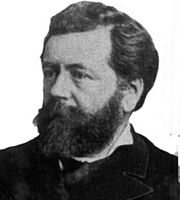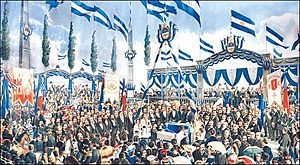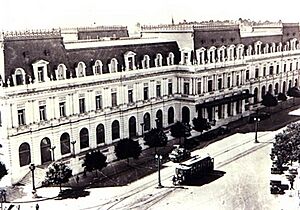Dardo Rocha facts for kids
Quick facts for kids
Dardo Rocha
|
|
|---|---|
 |
|
| Rector of the University of La Plata | |
| In office 1897–1905 |
|
| Preceded by | post created |
| Succeeded by | Joaquín V. González |
| Governor of Buenos Aires | |
| In office May 1, 1881 – May 1, 1884 |
|
| Preceded by | Juan José Romero |
| Succeeded by | Carlos Alfredo D'Amico |
| Personal details | |
| Born | September 1, 1838 Buenos Aires |
| Died | September 6, 1921 (aged 83) Buenos Aires |
| Political party | National Autonomist Party |
| Spouse | Paula Arana |
| Occupation | Lawyer and academic |
Dardo Rocha (born September 1, 1838 – died September 6, 1921) was an important Argentine naval officer, lawyer, and politician. He is most famous for founding the city of La Plata and starting the University of La Plata.
Contents
Life and Early Career
Dardo Rocha was born in Buenos Aires in 1838. His father, Juan José Rocha, was a military officer who opposed the government of Governor Juan Manuel de Rosas.
Dardo Rocha began studying law at the University of Buenos Aires in 1858. However, he paused his studies to join the navy in 1859. He fought in the Battle of Pavón in 1861. This battle helped unite the Province of Buenos Aires with the rest of Argentina.
He earned his law degree in 1863. He continued serving in the Argentine Navy during the Paraguayan War. He was seriously injured in the 1866 Battle of Curupaity. After this, he returned to civilian life as a lawyer. In 1873, he married Paula Arana, and they had five children.
Political Life and Achievements
In 1870, Dardo Rocha helped with the Constitutional Reform Convention for Buenos Aires Province. In 1873, he was elected to the Argentine Chamber of Deputies, which is like the lower house of Argentina's parliament. The next year, in 1874, he became a Senator.
As a Senator, he became a key member of the National Autonomist Party. This party wanted to make Buenos Aires a federal capital, separate from the province. Rocha strongly supported this idea. He also worked on laws to control trade along the Bermejo River. He helped create Argentina's first patent laws and supported protecting local industries.
Becoming Governor
Rocha's work in the Senate made him well-known. In 1876, he became the Provisional President of the Senate. This meant he sometimes acted as President of Argentina when the actual president, Nicolás Avellaneda, was ill.
In 1880, Julio Roca became President. He supported Dardo Rocha to become Governor of Buenos Aires Province. This was a very important and often difficult position. After some political unrest, Rocha convinced voters to support him. He was elected governor in 1881.
Founding La Plata
Buenos Aires City became the nation's capital in 1880. This meant the province of Buenos Aires needed a new capital city. Governor Rocha suggested creating a brand new city for this purpose. This idea helped calm people in the province who wanted more independence. Congress quickly approved his plan.
Governor Rocha hired architect Pedro Benoit to design the new city. Benoit created a unique plan with diagonal streets and perfectly placed squares. Rocha oversaw a huge amount of construction. He officially opened the city of La Plata on November 19, 1882. It was the first planned city in South America and the first to have electric lighting.
Later Years and Legacy
Rocha's success as governor and with La Plata made him want to become President in 1886. He was a popular and influential candidate. However, he lost the nomination to Miguel Juárez Celman, who was President Roca's son-in-law.
After leaving office, Rocha went back to journalism. He managed the political news desk at El Nacional in La Plata until 1889. He kept a low political profile after a major political crisis in 1890. Instead, he focused on the growing city he had founded.

In 1897, he established the University of La Plata. He served as its president until 1905, when the school became a national university. He also taught Constitutional Law there. In 1904, he was an Argentine observer for a border agreement between Bolivia and Chile.
Dardo Rocha passed away in Buenos Aires in 1921 at the age of 83. His former home in La Plata is now a museum and archive. His burial place became a topic of discussion. He was first buried in Buenos Aires. Later, his eldest son, Carlos Rocha, asked for his remains to be moved to the Cathedral of La Plata. Some family members later questioned this decision, believing it was not what Dardo Rocha would have wanted.
See also
 In Spanish: Dardo Rocha para niños
In Spanish: Dardo Rocha para niños



